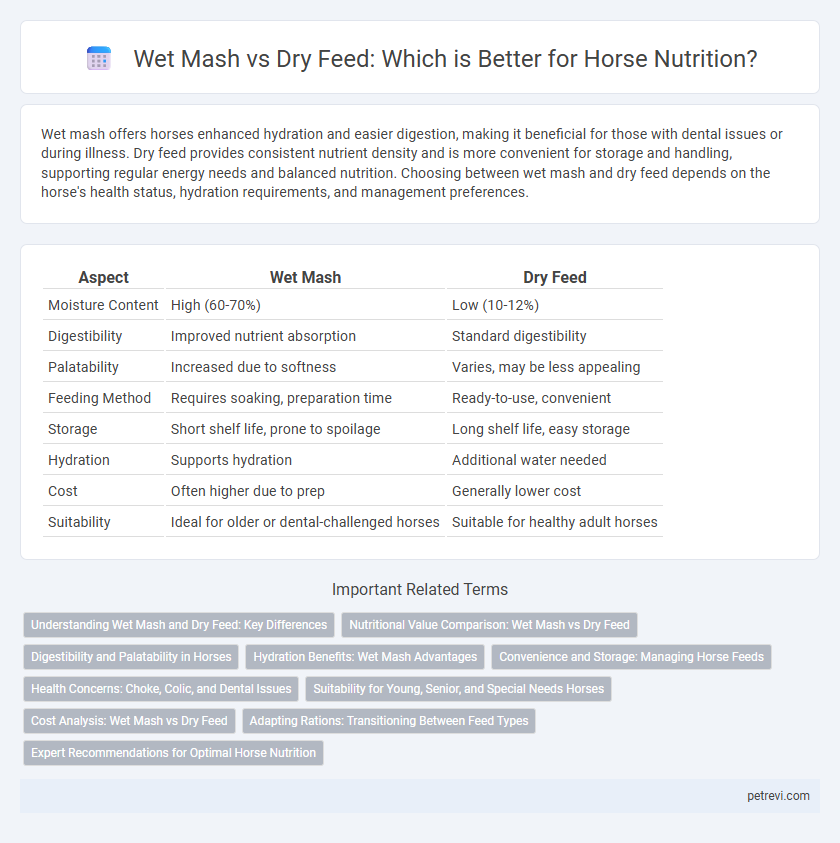Wet mash offers horses enhanced hydration and easier digestion, making it beneficial for those with dental issues or during illness. Dry feed provides consistent nutrient density and is more convenient for storage and handling, supporting regular energy needs and balanced nutrition. Choosing between wet mash and dry feed depends on the horse's health status, hydration requirements, and management preferences.
Table of Comparison
| Aspect | Wet Mash | Dry Feed |
|---|---|---|
| Moisture Content | High (60-70%) | Low (10-12%) |
| Digestibility | Improved nutrient absorption | Standard digestibility |
| Palatability | Increased due to softness | Varies, may be less appealing |
| Feeding Method | Requires soaking, preparation time | Ready-to-use, convenient |
| Storage | Short shelf life, prone to spoilage | Long shelf life, easy storage |
| Hydration | Supports hydration | Additional water needed |
| Cost | Often higher due to prep | Generally lower cost |
| Suitability | Ideal for older or dental-challenged horses | Suitable for healthy adult horses |
Understanding Wet Mash and Dry Feed: Key Differences
Wet mash consists of grains and supplements soaked in water, enhancing digestibility and hydration for horses, while dry feed offers convenience and longer shelf life but requires adequate water intake to prevent dehydration. Nutrient absorption varies as wet mash promotes faster enzymatic activity in the gut, whereas dry feed relies on salivation and chewing efficiency for proper breakdown. Choosing between wet mash and dry feed depends on the horse's health, workload, and environmental conditions to optimize nutrient utilization and maintain digestive health.
Nutritional Value Comparison: Wet Mash vs Dry Feed
Wet mash offers enhanced hydration and can improve nutrient absorption compared to dry feed, which retains all original nutrients but may require increased water intake. The fermentation process in wet mash can increase the bioavailability of certain vitamins and minerals, supporting better digestive health. Dry feed often contains higher fiber content essential for equine gut function, whereas wet mash may have reduced fiber levels due to moisture content.
Digestibility and Palatability in Horses
Wet mash feed enhances digestibility in horses by increasing moisture content, which promotes better nutrient absorption and reduces the risk of impaction colic. The higher palatability of wet mash encourages greater voluntary intake, supporting hydration and overall gut health. Dry feed offers convenience and longer shelf life but may be less appealing, potentially leading to reduced feed intake and suboptimal digestive efficiency in sensitive horses.
Hydration Benefits: Wet Mash Advantages
Wet mash feed significantly enhances a horse's hydration by providing additional moisture content compared to dry feed, supporting optimal fluid balance and preventing dehydration. The increased water intake from wet mash aids in maintaining healthy digestive function and reduces the risk of colic, which is often associated with insufficient hydration. This hydration boost also promotes better nutrient absorption, contributing to overall equine health and performance.
Convenience and Storage: Managing Horse Feeds
Wet mash offers ease of feeding with pre-soaked grains that reduce dust and promote hydration, but requires immediate use or refrigeration to prevent spoilage. Dry feed provides superior convenience through long shelf life and simple storage, making it ideal for managing bulk quantities with minimal preparation. Selecting between them depends on balancing timely feeding practices versus storage capacity and stability for consistent horse nutrition.
Health Concerns: Choke, Colic, and Dental Issues
Wet mash reduces the risk of choke in horses by softening feed particles, making swallowing easier compared to dry feed that can cause blockages. However, improper soaking or fermentation in wet mash may increase colic risk due to bacterial overgrowth and fermentation gases. Dental issues can be managed better with dry feed since chewing stimulates saliva production and natural tooth wear, whereas wet mash may reduce chewing activity and impact dental health negatively.
Suitability for Young, Senior, and Special Needs Horses
Wet mash offers enhanced hydration and easier digestibility, making it ideal for young foals, senior horses, and those with dental or swallowing difficulties. Dry feed provides stable nutrients and convenient storage but may pose challenges for horses with compromised chewing ability or sensitive digestion. Nutritional plans should prioritize wet mash for special needs horses to ensure optimal nutrient absorption and hydration balance.
Cost Analysis: Wet Mash vs Dry Feed
Wet mash feed often incurs higher costs due to water usage, preparation time, and potential feed spoilage, while dry feed typically offers lower purchase and storage expenses. Evaluating cost-effectiveness involves comparing nutrient density per dollar, with dry feed generally providing more stable shelf life and lower wastage. Horses digest wet mash efficiently, but the financial outlay must consider ongoing labor and moisture management versus the straightforward handling of dry feed options.
Adapting Rations: Transitioning Between Feed Types
Adapting rations when transitioning between wet mash and dry feed requires careful monitoring of a horse's digestive response to prevent colic or laminitis. Gradual introduction over 7-10 days allows the gut microbiota to adjust, maintaining nutrient absorption and hydration balance. Evaluating fiber content, starch levels, and moisture percentage in each feed type ensures optimal energy delivery and digestive health during the transition.
Expert Recommendations for Optimal Horse Nutrition
Experts emphasize the importance of balancing Wet Mash and Dry Feed to optimize horse nutrition, as Wet Mash improves hydration and nutrient absorption while Dry Feed ensures fiber intake and dental health. Research highlights that Wet Mash can reduce dust-related respiratory issues common with dry feeds, promoting better overall digestive function. Tailoring feed types to individual horse needs and activity levels ensures optimal nutrient delivery and supports peak equine performance according to veterinary nutritionists.
Wet Mash vs Dry Feed for Horse Nutrition Infographic

 petrevi.com
petrevi.com